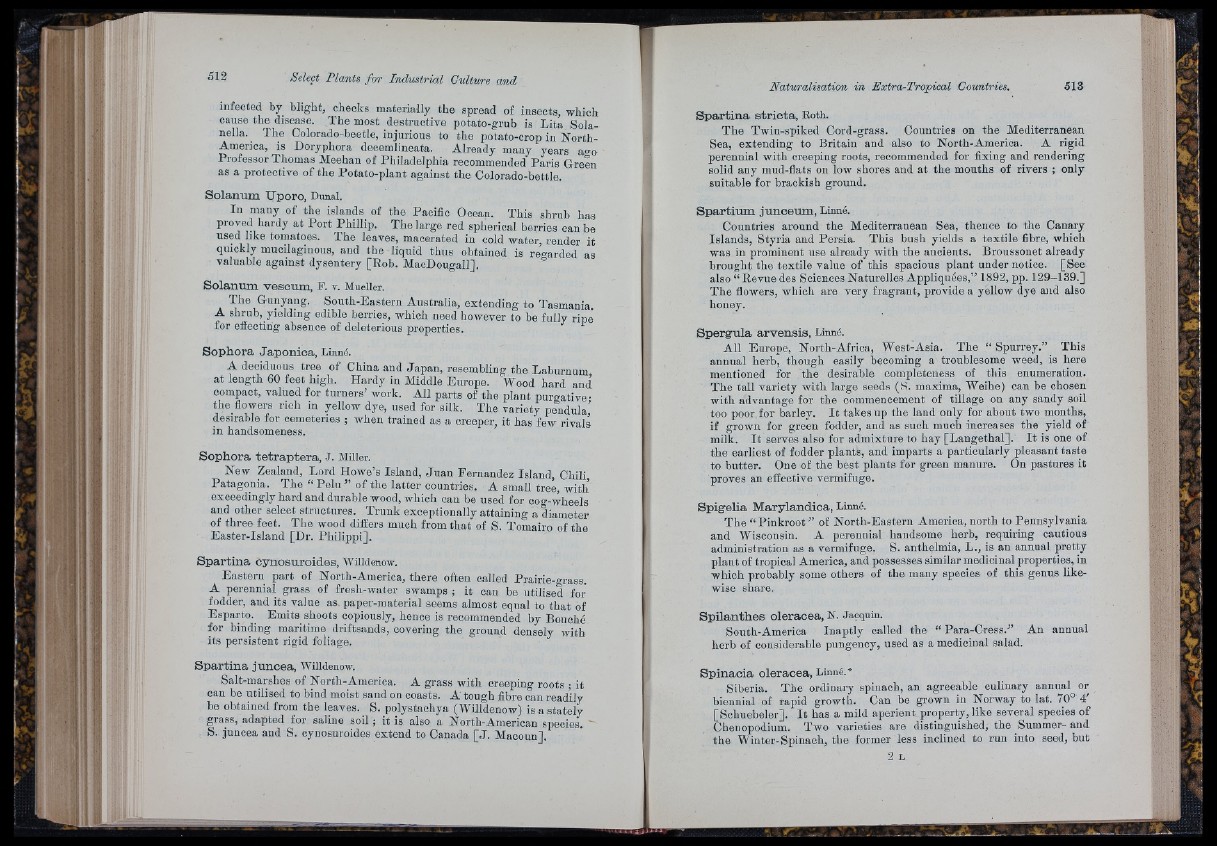
infected by blight, checks materially the spread of insects, which
cause the disease. The most destructive potato-grub is Lita Sola-
nella. The Colorado-beetle, injurious to the potato-crop in North-
Ameriea, is Doryphora decemlineata. Already many years ago
Professor Thomas Meelian of Philadelphia recommended Paris Green
as a protective of the Potato-plant against the Colorado-bettle.
S o la n um U p o ro , Dunal.
In many of the islands of the Pacific Ocean. This shrub has
proved hardy a t Po rt Phillip. The large red spherical berries can be
used like tomatoes. The leaves, macerated in cold water, render it
quickly mucilaginous, and the liquid thus obtained is regarded as
valuable against dysentery [Rob. MacDougall],
S o la n um v e s c um , P. v. Mueller.
The Gunyaug. South-Eastern Australia, extending to Tasmania.
A shrub, yielding edible berries, which need however to be fully ripe
for effecting absence of deleterious properties.
S o p h o r a J a p ó n ic a , Linné.
A deciduous tree of China and Japan, resembling the Laburnum
at length 60 feet high. Hardy in Middle Europe. Wood hard and
compact, valued for turners’ work. All parts of the plant purgative-
the flowers rich in yellow dye, nsed for silk. The variety pendula’
desirable for cemeteries ; when trained as a creeper, it has few rivals
in handsomeness.
S o p h o r a te t r a p t e r a , J. Miller.
New Zealand, Lord Howe’s Island, Ju a n Fernandez Island, Chili
Patagonia. The “ Pelu ” of the latter countries. A small tree, with
exceedingly hard and durable wood, which can be used for cog-wheels
and other select structures. Trunk exceptionally attaining a diameter
of three feet. The wood differs much from that of S. Tomairo of the
Easter-Island [Dr. Pliilippi].
S p a r t in a o y n o su ro id e s , Willdenow.
Eastern part of North-America, there often called Prairie-grass.
A perennial grass of fresh-water swamps ; it can be utilised for
fodder, aud its value as paper-material seems almost equal to th a t of
Esparto.^ Emits shoots copiously, heiiee is reoommended by Bouché
for binding maritime driftsands, covering the ground densely with
its persistent rigid foliage.
S p a r tin a ju n c e a , Willdenow.
Salt-marshes of North-America. A grass with creeping roots ; it
can be utilised to bind moist sand on coasts. A tough fibre can readily
he obtained from the leaves. S. polystaohya (Willdenow) is a stately
grass, adapted for saline soil ; it is also a North-American species. '
S. juncea and S. cynosuroides extend to Canada [ J . Macoun].
Naturalisation in Extra-Tropical Countries.
S p a r t in a s t r ic ta , Roth.
The Twin-spiked Cord-grass. Countries on the Mediterranean
Sea, extending to Britain and also to North-America. A rigid
perennial with creeping roots, recommended for fixing and rendering
solid any mud-flats on low shores and a t the mouths of rivers ; only
suitable for brackish ground.
S p a r t ium ju n c e um , Linné.
Countries around the Mediterranean Sea, thence to the Canary
Islands, Styria and Persia. This bush yields a textile fibre, which
was in prominent use already with the ancients. Broussonet already
brought the textile value of this spacious plant under notice. [See
also “ Revue des Sciences Naturelles Appliquées,” 1892, pp. 129-139.]
The flowers, which are very fragrant, provide a yellow dye and also
honey.
S p e i^ u la a rv e n s is , Linné.
All Europe, North-Africa, West-Asia. The “ Spurrey.” This
annual herb, though easily becoming a troublesome weed, is here
mentioned for the desirable completeness of tliis enumeration.
The tall variety with large seeds (S. maxima, Weihe) can be chosen
with advantage for the commencement of tillage on any sandy soil
too poor for barley. I t takes up the land only for about two months,
if grown for green fodder, and as such much increases the yield of
milk. I t serves also for admixture to hay [Langethal]. I t is one of
the earliest of fodder plants, and imparts a particularly pleasant taste
to butter. One of the best plants for green manure. On pastures it
proves an effective vermifuge.
S p ig e lia M a ry la n d ic a , Linué.
The “ P in k ro o t” of North-Eastern America, north to Pennsylvania
and Wisconsin. A perennial handsome herb, requiring cautious
administration as a vermifuge. S. anthelmia, L., is an annual pretty
plant of tropical America, and possesses similar medioinal properties, in
which probably some others of the many species of this genus likewise
share,
S p ila n th e s o le rao e a , N. Jacquin.
South-America Inaptly called the “ Para-Cress.” An annual
herb of considerable pungency, used as a medicinal salad.
S p in a c ia o le rao e a , Linné.*
Siberia. The ordinary spinach, an agreeable culinary annnal or
biennial of rapid growth. Can he grown in Norway to lat. 70° 4
[Schuebeler]. I t has a mild aperient property, like several species of
Chenopodium. Two varieties are distinguished, the Summer- and
the Winter-Spinach, the former less inclined to run into seed, but
2 L
'.■'Í. '